14
NovStorage Account in Azure: Types, Features, and Real-World Uses
When working with cloud services, it's crucial to store data safely and access it whenever needed. That’s where the Storage Account in Azure comes in. It’s like a powerful cloud-based locker where you can store different types of data, files, images, videos, databases, and more.
The Storage Account in Azure helps you manage this data securely, scale it, and do so cost-effectively. Whether you're building a website, a mobile app, or a business system, Azure makes it easy to store and retrieve your data whenever you need it. Azure skills are projected to boost your earning potential by 20% in the next 3 years. Enroll now in our Azure Fundamentals Free Course with Certification!
In the Azure Tutorial, let's learn about Storage Accounts in Azure in a step-by-step manner.
What are Azure Storage Accounts?
Azure Storage Accounts are services provided by Microsoft Azure that allow you to store different types of data in the cloud. This includes files, images, videos, documents, backups, and even large data for applications.
In simple terms, a Storage Account in Azure functions like an online storage space, where you can securely store your data and access it from anywhere. It supports multiple storage types, including blobs (for large files), files (for shared access), queues (for messaging), and tables (for structured data).
Types of Storage Accounts in Azure
Azure offers different types of storage accounts to meet various data storage needs, depending on performance, pricing, and use case.
- General-purpose v2 (GPv2) Storage Account
- General-purpose v1 (GPv1) Storage Account
- Blob Storage Account
- BlockBlob Storage Account
- FileStorage Account
- Premium Page Blob Storage Account
Let's understand each of the storage accounts in Azure in detail.
1. General-purpose v2 (GPv2) Storage Account
The General-purpose v2 (GPv2) Storage Account is the most commonly used and recommended type in Azure. It supports all the latest Azure storage features and gives you access to different types of storage services like Blobs, Files, Queues, and Tables,all in one place.
It also offers multiple performance tiers (Standard and Premium). It supports features like lifecycle management, soft delete, and access tiers (Hot, Cool, Archive) to help manage data more efficiently and save costs.
2. General-purpose v1 (GPv1) Storage Account
General-purpose v1 (GPv1) Storage Account is the older version of Azure Storage. It supports blobs, files, queues, and tables, but lacks new features like access tiers and lifecycle management. It's cheaper for some tasks, but not recommended for new projects.
3. Blob Storage Account
The Blob Storage Account is designed only for storing blob data, like images, videos, documents, and backups. It supports Hot and Cool access tiers to help you manage costs based on how often you access the data. In simple words, it’s best when you just need to store large unstructured files in the cloud.
4. BlockBlob Storage Account
The BlockBlob Storage Account is explicitly optimized for storing block blobs, which are large files broken into smaller blocks (like videos or backups). It offers high performance and is excellent when you need fast access to big files. In simple terms, it’s a storage account built for handling large files efficiently.
5. FileStorage Account
The FileStorage Account is explicitly made for storing Azure Files, which lets you share files across multiple machines just like a traditional file server. It provides high performance and is good for applications that need fast and shared access to files. In short, it’s perfect when you want cloud-based file shares with great speed.
6. Premium Page Blob Storage Account
The Premium Page Blob Storage Account is designed to store page blobs, which are used for things like Azure virtual machine disks. It offers high-performance and low-latency storage, making it ideal for workloads that need fast and reliable access to data.
Main Azure Storage Services
The storage account in Azure includes several main storage services that help you store and manage different types of data easily. These services are all part of the storage account in Azure and work together to support your cloud applications. There are five core storage services in total.
- Blob Storage
- File Storage
- Queue Storage
- Table Storage
- Disk Storage
1. Blob Storage in Azure
Blob Storage in Azure is a way to save big files like photos, videos, or documents on the internet instead of your computer. It helps you keep these files safe and lets you access them anytime from anywhere. It’s great for apps or websites that need to store lots of data and want to grow easily without problems.

Azure Blob Storage has three types of blobs, each made for a different way to store data:
- Block Blobs: These store large files like photos or videos. The files are broken into smaller blocks and saved separately. It’s the most common type used for uploading big files.
- Append Blobs: These are good for adding data at the end, like writing logs or records. You can keep adding new data without changing the existing data.
- Page Blobs: These are used when you need to read and write data quickly at random locations, such as on virtual machine disks or databases.
Use Cases of Azure Blob Storage
- Storing Images and Videos: Used by apps and websites to save photos, videos, and other media files.
- Backup and Restore: Companies use it to store backups of their important data safely in the cloud.
- Big Data and Analytics: Stores large data files that can be used for analysis or reporting.
- Hosting Files for Websites: Used to store and serve files like documents, PDFs, or static website content.
Access Tiers in Azure Blob Storage
Azure Blob Storage offers three access tiers to help you save money based on how often you use your data. These tiers are like different storage plans, and you can pick the one that best fits your needs.
1. Hot Tier: This is for files you use very often, like every day. It’s more expensive to store but cheaper and faster to use. Great for active files like website images or daily documents.
2. Cool Tier:This is for files you don’t use often, maybe once a month. It’s cheaper to store but costs more when you open or change the files. Good for backups or old reports.
3. Archive Tier: This is for files you almost never use, like once a year. It’s the cheapest to store but takes hours to open. Best for keeping old records or legal files just in case.
Security in Azure Blob Storage
Azure Blob Storage keeps your files safe by using automatic encryption. This means all your data is turned into a secret code so that no one can read it without permission. Even if someone gets access to the files, they won’t understand the data unless they’re allowed.
You can also control who can view or change your files by setting permissions. Azure lets you share access for a limited time using secure links (called SAS). You can also block unknown users or allow only trusted networks to connect. So, your data stays private and protected.
Integration in Azure
The storage account in Azure works really well with many other Azure services, which makes it super helpful for real-world projects. Here’s how it connects with different tools and services:
- You can use it with Azure Virtual Machines to store virtual hard disks (VHDs) safely in the cloud.
- It works with Azure Functions, so when a file is uploaded, you can automatically run some code to process it.
- It connects with tools like Azure Logic Apps or Power Automate to help you move or copy files without writing any code.
- If you work with data, Azure Data Factory makes it easy to move and change data inside your storage account in Azure.
- You can also connect it to your apps using APIs and SDKs, so mobile apps or websites can upload or download files smoothly.
Azure Blob Storage Pricing
Azure Blob Storage offers three primary access tiers, Hot, Cool, and Archive—each designed to optimize storage costs based on data access frequency. Below is a comparison of the pricing for these tiers in both India and the USA:
| Access Tier | India (₹ per GB per month) | USA ($ per GB per month) |
| Hot Tier | ₹1.45 | $0.018 |
| Cool Tier | ₹1.00 | $0.01 |
| Archive Tier | ₹0.20 | $0.002 |
Source: Official Microsoft Azure Blob Storage pricing
2. File Storage in Azure
Azure File Storage is a service in the storage account in Azure that works like a shared folder in the cloud. It lets you and others access and share files easily from anywhere. This makes it simple to use cloud storage just like a regular folder on your computer, inside a storage account in Azure.
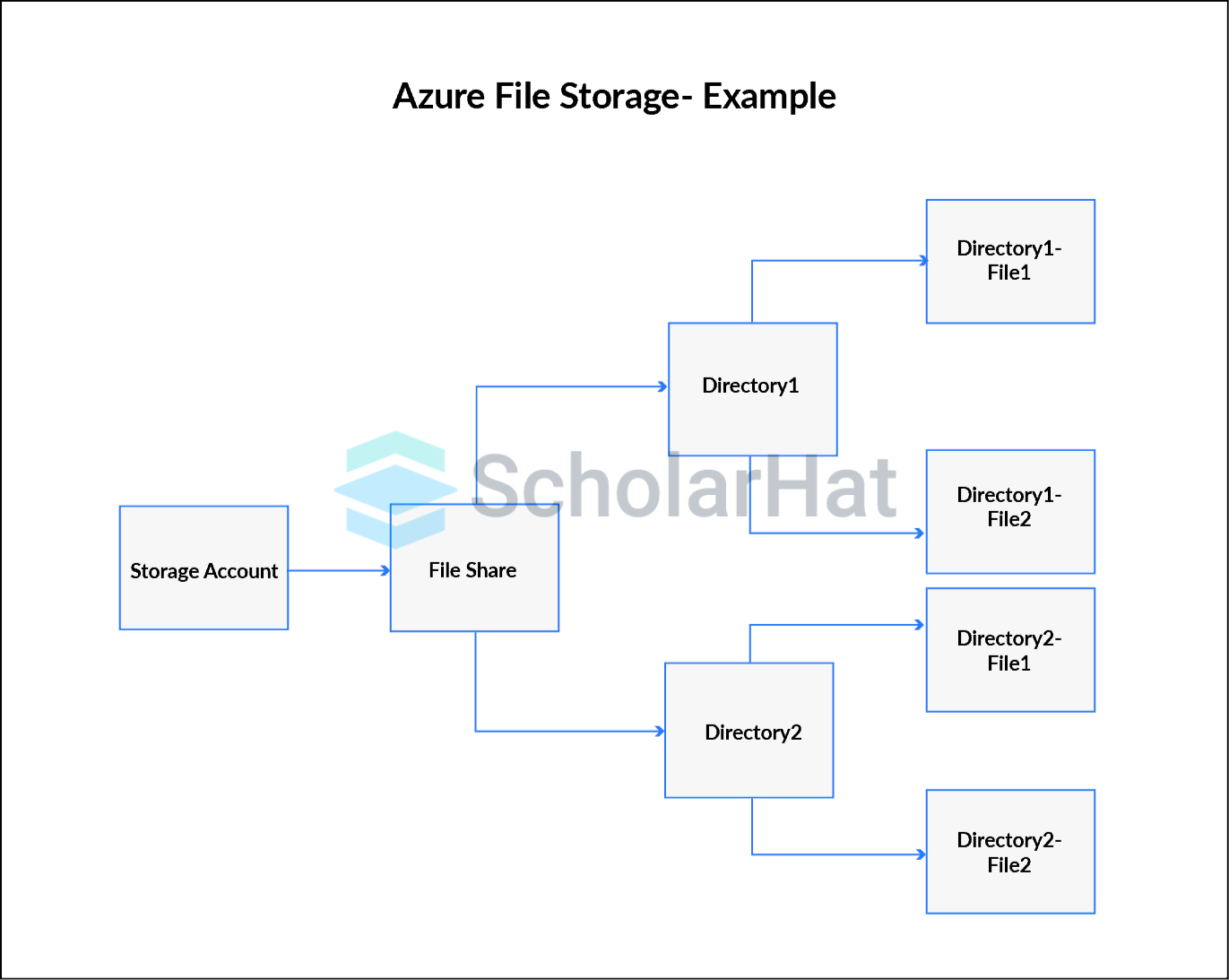
How does File Storage in Azure work?
Azure File Storage works like a shared folder on your computer, but in the cloud. You create a file share in your Azure storage account, and then many users or apps can connect to it over the internet using a standard file-sharing method called SMB.
This means you can save files in one place, and everyone who has permission can access, edit, or share those files from anywhere, just like a regular network drive.
Use Cases of Azure File Storage
- You can share files with your team anytime and from anywhere.
- It’s easy to move your old files to the cloud without changing how you use them.
- Azure File Storage helps apps share settings and data smoothly.
- It keeps your backups safe in case something goes wrong.
- Developers can work together efficiently by accessing shared files.
Performance of Azure File Storage
Azure File Storage has two speed options. The Standard one is good for regular use, like sharing files or storing stuff you don’t need super fast. The Premium one is faster and better when you need quick access, like for essential apps or big jobs. You just choose what fits you best.
Security in Azure File Storage
- Your files are protected with strong encryption.
- You control who can access or change your files.
- Works with Azure Active Directory for secure user access.
- Keeps your data safe from unauthorized users.
3. Queue Storage in Azure
Queue Storage in Azure is like a message box in the cloud where different parts of an app can leave messages for each other. It helps apps talk smoothly by sending, storing, and receiving messages one at a time, even if they aren’t working simultaneously. This way, everything stays organized, and nothing gets lost.
How does Queue Storage in Azure work?
Let’s see how Queue Storage in Azure helps apps send messages without losing them:
- Imagine you have a message that needs to be delivered, but not right away. You put that message in a waiting line called a queue.
- One part of your app sends this message and places it into the queue inside your storage account in Azure.
- Later, another part of your app picks up the message and processes it when it’s ready.
- This is very helpful when different parts of your app run at different speeds or times.
- Your storage account in Azure ensures that all these messages stay safe, organized, and processed one by one.
Common Use Cases of Queue Storage in Azure
Let’s look at some real-life examples where Queue Storage is very useful:
- Processing Orders: When users place orders on a website, each order can be added to a queue. The app can then process them one by one without getting overloaded.
- Background Tasks:You can use it to handle tasks that don’t need to happen right away, like sending emails or creating reports, in the background.
- Communication Between Services: If two parts of an app need to talk but don’t work at the same speed, a queue helps them pass messages without crashing or slowing down.
- Handling High Traffic: During busy times, like sales or events, queues help manage the load by lining up requests instead of handling everything at once.
Security and Access Control in Queue Storage in Azure
Let’s understand how Azure keeps your queue messages safe and makes sure only the right people can use them:
- Encryption: All messages in the queue are automatically encrypted. This means no one can read the messages unless they have permission.
- Access Keys: Azure gives special keys that allow apps or people to access the queue. These keys should be kept safe, just like a password.
- Shared Access Signatures (SAS): A special link called SAS allows you to give someone limited-time access. It lets you control what they can do—like read or add messages, and for how long.
- Azure Active Directory (AAD): You can also use AAD to manage who can access the queue using their identity. It’s great for teams working in large organizations.
- Role-Based Access Control (RBAC): Azure lets you assign roles like “Reader” or “Contributor” to control what each person can do with the queue.
Pricing in Queue Storage in Azure
Below is a basic comparison of Queue Storage pricing in India and the USA (approximate values and may vary slightly by region and usage):
| Pricing Component | India (INR) | USA (USD) |
| Storage Cost | ₹0.60 per GB per month | $0.007 per GB per month |
| Write Operations (per 10,000) | ₹0.33 | $0.004 |
| Read Operations (per 10,000) | ₹0.33 | $0.004 |
| Data Transfer Out (First 5 GB) | Free | Free |
| Data Transfer After 5 GB | ₹6 – ₹9 per GB (approx.) | $0.08 – $0.12 per GB (approx.) |
| Geo-Replication (Optional) | Extra ₹1.00 – ₹2.00 per GB (varies) | Extra $0.02 – $0.03 per GB (varies) |
Note: Always check the official Azure Pricing Calculator for the latest rates.
4. Table Storage in Azure
Table Storage in Azure is a way to store data in rows and columns, like a simple table. It’s good for storing things like user information or app data. You can create it inside a storage account in Azure, which can have many tables. The storage account in Azure helps keep your data safe and easy to use.
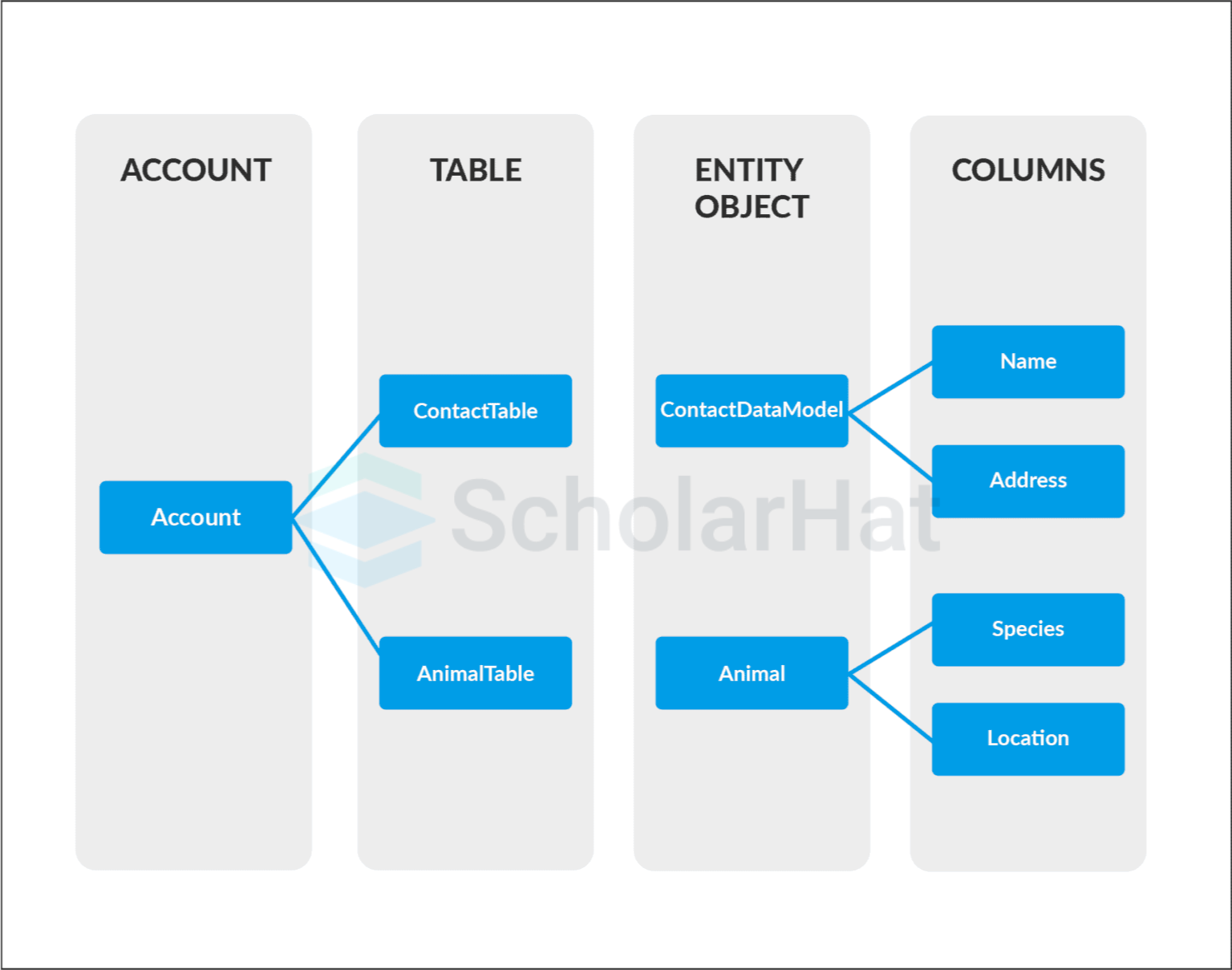
How does Table Storage in Azure work?
Let’s understand it in a very easy way:
- Data is stored in tables, but unlike in a normal database, there are no fixed rules; each row can have different fields.
- Each row is called an entity, and every entity has a unique key to find it quickly.
- You store these tables inside your storage account in Azure.
- Table Storage is great when you need to store a lot of data and want fast access without spending a lot of money.
- It’s a NoSQL service, so it's super flexible and easy to scale.
Common Use Cases of Table Storage in Azure
Let’s see some common ways Table Storage in Azure is used in real-world applications:
- Storing User Data:You can save information like usernames, email IDs, or user settings in a simple table format.
- App Configuration or Settings: Developers use it to store app settings that the app can quickly read and update.
- Logging and Monitoring: Table Storage is excellent for saving logs, such as who did what and when, because it handles large amounts of data easily.
- Product or Item Catalogs:E-commerce apps use it to store product details like names, prices, and descriptions.
- IoT Data Storage:Devices like sensors can send small bits of data often, and Table Storage can store this without becoming overloaded.
Pricing in Table Storage in Azure
The basic idea of how Table Storage pricing works in Azure for India and the USA:
| Pricing Component | India (INR) | USA (USD) |
| Storage Cost | ₹0.60 per GB per month | $0.007 per GB per month |
| Write Operations (per 10,000) | ₹0.33 | $0.004 |
| Read Operations (per 10,000) | ₹0.33 | $0.004 |
| List/Delete Operations (per 10,000) | ₹0.33 | $0.004 |
| Geo-Replication (if enabled) | Extra ₹1 – ₹2 per GB (approx.) | Extra $0.02 – $0.03 per GB (approx.) |
Source: Azure Pricing Calculator
5. Disk Storage in Azure
Disk Storage in Azure is a service that provides virtual hard drives for your cloud computers, called virtual machines (VMs). These disks store all your data, like your files, apps, and the operating system, just like a hard drive in your regular computer.
Types of Disks in Azure
Azure offers different types of disks to meet various needs, from fast performance to cost-effective storage.
- Premium SSD: This fast and reliable disk is perfect for apps that need high performance, like databases.
- Standard SSD: A balanced disk that is cheaper than Premium SSD but still faster than regular hard drives.
- Standard HDD: The most basic and low-cost disk, good for less critical tasks or backups.
- Ultra Disk: The fastest and most powerful disk type for apps that need very high speed and low delay.
How does Disk Storage work in Azure?
Let’s understand how disk storage works step-by-step:
- When you create a virtual machine (VM), you attach a disk to it, which acts like the computer’s hard drive.
- The disk stores your operating system, apps, and data on your PC just like a regular hard drive.
- Disks are managed by Azure, so you don’t have to worry about physical hardware.
- You can choose different disk types depending on your performance and budget needs.
- The data on the disk is stored safely and backed up using Azure’s built-in protection.
Key Features and Benefits of Disk Storage
- High Performance: Disk Storage offers fast read and write speeds, helping your apps run smoothly.
- Durability: Your data is safe with Azure’s replication and backup options.
- Scalability: You can easily increase or decrease disk size as your needs change.
- Flexibility: Choose from different disk types based on your budget and speed requirements.
- Managed Service: Azure handles the maintenance and hardware, so you can focus on your applications.
Pricing Model in Disk Storage
The typical pricing for different disk types in India and the USA:
| Disk Type | India (INR per GB/month) | USA (USD per GB/month) |
| Premium SSD | ₹10 – ₹15 | $0.12 – $0.20 |
| Standard SSD | ₹4 – ₹7 | $0.05 – $0.10 |
| Standard HDD | ₹2 – ₹4 | $0.02 – $0.05 |
| Ultra Disk | ₹20 – ₹30 | $0.25 – $0.40 |
Source: Azure Pricing Calculator
How to create a Storage Account in Azure
Dear learners, if you want to create a storage account in Azure, follow these simple steps.
Note: To create a storage account in Azure, you should have an Azure subscription.
Step 1: In the Azure portal, search for 'Storage accounts' and select it.

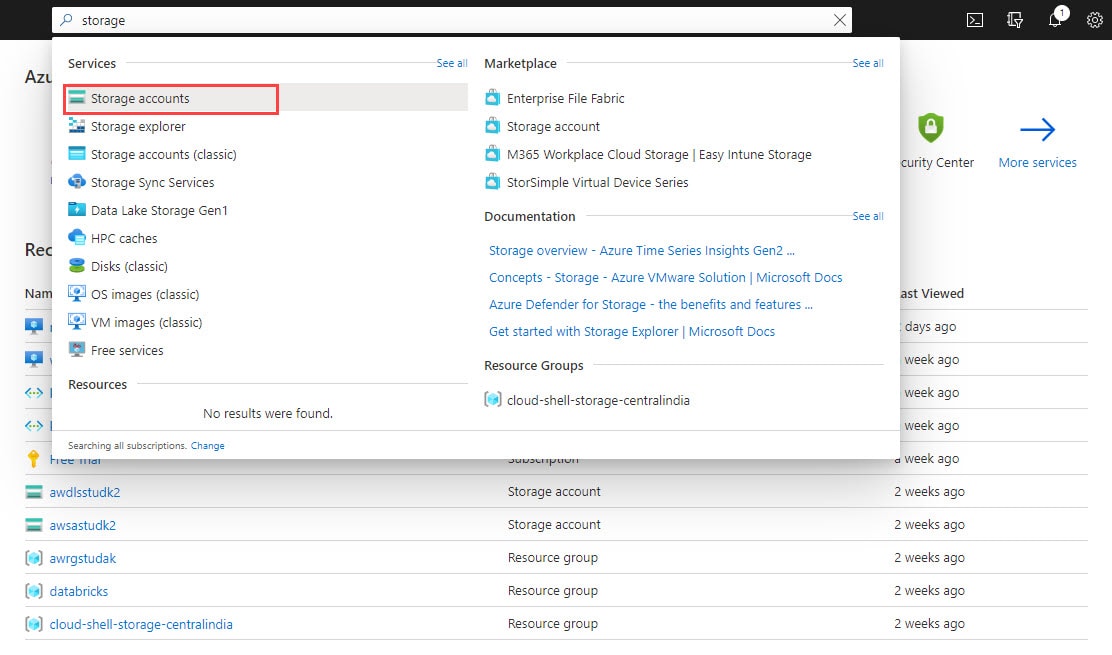
Step 2: "Click on Add to create a new storage account. Choose your subscription and select the desired resource group. Then, enter a unique name for your storage account and pick the location where you want it to be hosted. After that, select the account kind, choose the replication type, and set the access tier. Finally, click on Review + Create to proceed.


Step 3: Wait for the validation process to complete successfully, then click on Create. Azure will begin deploying your storage account. Once the deployment is finished, you’ll see a notification. Simply click on Go to Resource to open your newly created Storage Account.

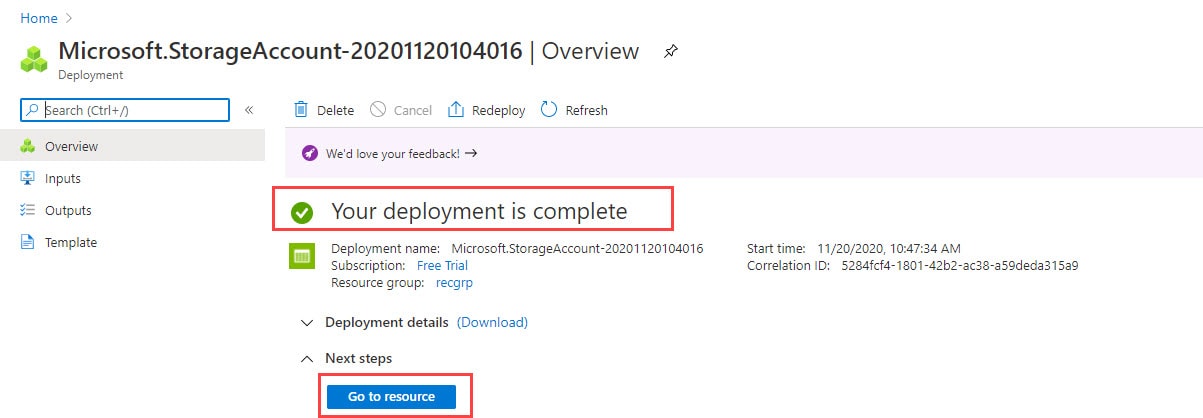
How to delete a Storage Account in Azure
To delete a Storage Account in Azure, follow these simple steps below to remove it from your account safely.
Step 1: Click on Storage Accounts from the left menu, or, if you can’t find it easily, search for it at the top.
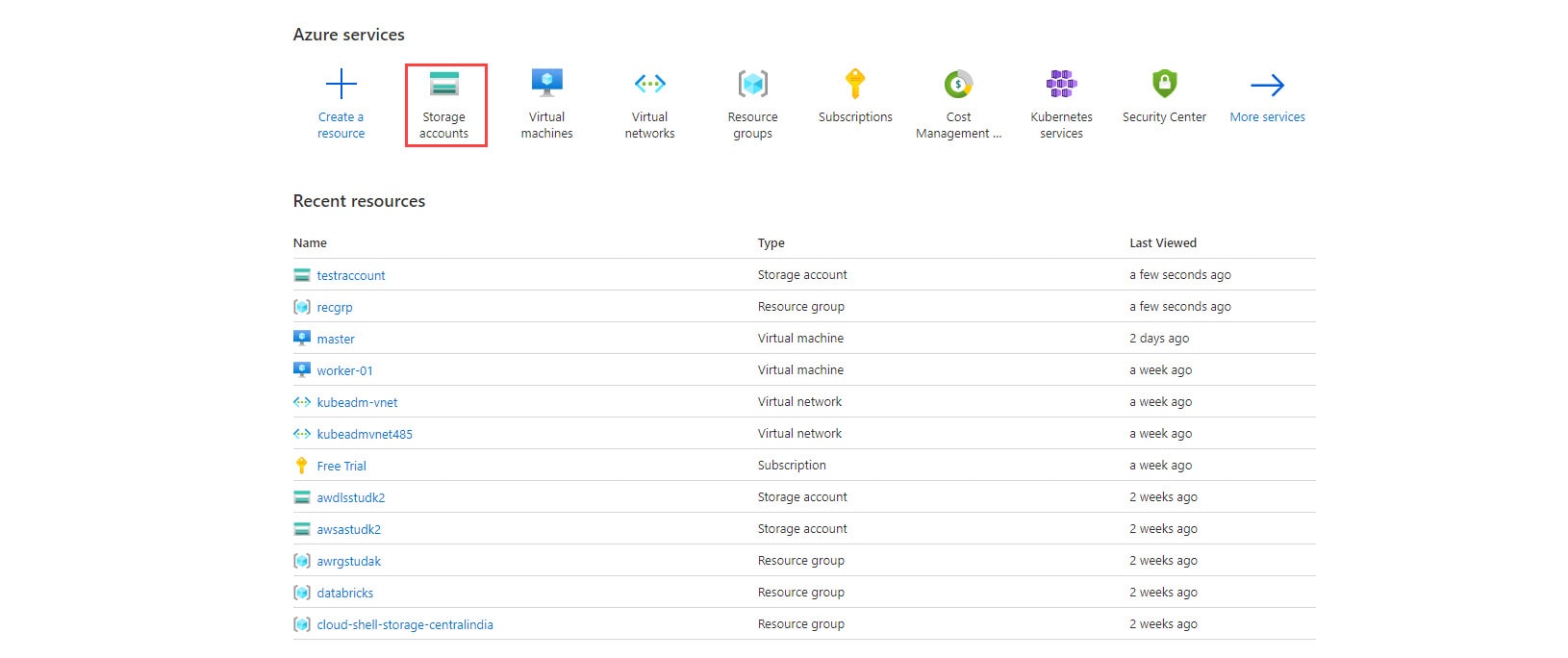
Step 2:Now, let’s select the storage account you want to delete. In this example, I’m choosing the one named "test".

Step 3: Now, a new window will open showing all the storage account details. Here, simply click on the Delete option.

Step 4: To complete the deletion process, you’ll need to confirm it by typing the name of your storage account in the box provided and then clicking on the Delete button.
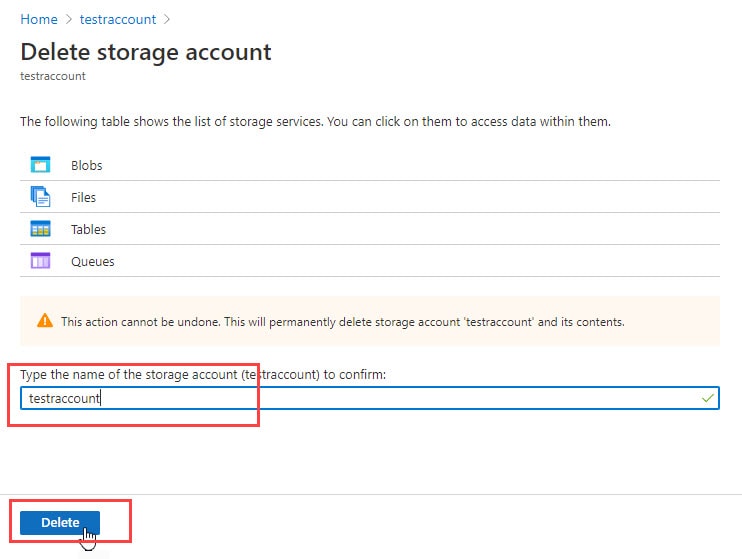
Advantages of Storage Account in Azure
Using a Storage Account in Azure comes with many helpful benefits that make storing and managing data easier and more secure.
- Easy to Use: Azure Storage is simple to set up and manage, even for beginners.
- Highly Scalable: It can grow with your needs, from small apps to big enterprise solutions.
- Cost-Effective: You pay only for what you use, with flexible pricing options.
- Secure: Azure automatically encrypts your data and offers strong access controls.
- Multiple Storage Options: You can store files, tables, blobs, and queues, all in one place.
- Reliable: Azure ensures high availability and backups, so your data is safe.
| Boost your career and become in-demand, join the Azure Cloud DevOps Engineer Certification Training today and master real-world DevOps skills on Azure! |
Conclusion
A Storage Account in Azure is a powerful and flexible way to store different types of data in the cloud. Whether you’re saving files, handling messages, or managing large databases, Azure offers fast, secure, and scalable storage services. By understanding Storage Account in Azure types, features, and pricing, you can choose the right storage option for your project.
In the next 3 years, 75% of developer roles will require Azure expertise. Don’t lag behind. Join our Azure Developer Course now!
If you are preparing for the Azure Developer Interview Questions and Answers Book, this Azure Interview Questions and Answers Book can really help you. It has simple questions and answers that are easy to understand. Download and read it for free today!
💡 Test your skills in Azure Storage Accounts with this interactive quiz!
Test your knowledge and boost your confidence by attempting Storage Accounts in Azure MCQs, perfect for mastering cloud storage concepts!
Q 1: Which of the following is NOT a type of Azure Storage?
FAQs
- Standard storage is cheaper and uses hard drives (HDDs), good for general-purpose data.
- Premium storage is faster, uses solid-state drives (SSDs), and is ideal for high-performance workloads.
- LRS (Locally Redundant Storage)
- GRS (Geo-Redundant Storage)
- ZRS (Zone-Redundant Storage)
- RA-GRS (Read-Access Geo-Redundant Storage)
Take our Azure skill challenge to evaluate yourself!

In less than 5 minutes, with our skill challenge, you can identify your knowledge gaps and strengths in a given skill.










